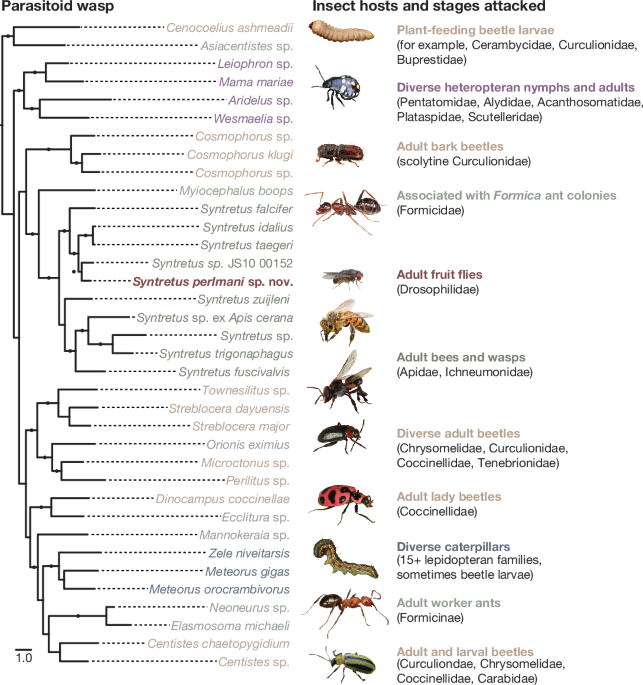Discovery of a Parasitoid Wasp Species that Infects Adult Fruit Flies, Including the Model Organism Drosophila melanogaster
Temel Kavramlar
A newly discovered parasitoid wasp species can infect and develop inside adult fruit flies, including the model organism Drosophila melanogaster, providing new research opportunities across the life sciences.
Özet
The content describes the discovery of a parasitoid wasp species that can infect and develop inside adult fruit flies, including the model organism Drosophila melanogaster. This is the first known wasp species that attacks the adult stage of a fly host.
The key highlights and insights include:
- Parasitoid wasps are exceptionally diverse and can manipulate the physiology and behavior of their host organisms.
- Nearly 200 described and provisional parasitoid species of drosophilids (fruit flies) have been identified, but none were previously known to attack the adult stage.
- The newly discovered wasp species can be easily collected from backyard fly baits and has a broad geographic distribution in the eastern USA.
- The researchers document the wasp's life history and unique host interactions, including egg-laying into and larval emergence from adult flies, and provide protocols to raise wasps from wild-caught host flies.
- This discovery emphasizes the need for ongoing research investment in insect biodiversity and systematics, as parasitoid research can provide fundamental insights into immunity, metabolism, ecology, evolution, and behavior.
- The wasp's association with the laboratory model organism D. melanogaster is expected to provide new research opportunities across the life sciences.
Özeti Özelleştir
Yapay Zeka ile Yeniden Yaz
Alıntıları Oluştur
Kaynağı Çevir
Başka Bir Dile
Zihin Haritası Oluştur
kaynak içeriğinden
Kaynak
www.nature.com
Drosophila are hosts to the first described parasitoid wasp of adult flies - Nature
İstatistikler
Nearly 200 described and provisional parasitoid species of drosophilids (fruit flies) have been identified.
Alıntılar
"Parasitoid wasps are exceptionally diverse and use specialized adaptations capable of manipulating the physiology and behaviour of host organisms1."
"Despite a deep history of research attention and remarkable biodiversity, a wasp species that attacks and develops inside the adult stage of a fly host has not been described previously."
Önemli Bilgiler Şuradan Elde Edildi
by Logan D. Moo... : www.nature.com 09-11-2024
https://www.nature.com/articles/s41586-024-07919-7
Daha Derin Sorular
How might the discovery of this parasitoid wasp species that infects adult Drosophila flies lead to new insights in fields beyond evolutionary biology, such as immunology or neuroscience?
The discovery of a parasitoid wasp species that specifically targets adult Drosophila flies, including the extensively studied Drosophila melanogaster, opens up numerous avenues for research across various scientific disciplines. In immunology, this unique interaction can provide insights into the host's immune response mechanisms. Researchers can investigate how Drosophila's immune system reacts to the wasp's egg-laying and larval development within its body, potentially revealing novel immune pathways or factors that could be applicable to other organisms, including humans.
Furthermore, the manipulation of host behavior and physiology by the wasp could shed light on neurobiological processes. Understanding how the wasp influences Drosophila's neural pathways to facilitate its own lifecycle may uncover fundamental principles of host-parasite interactions and behavioral ecology. This could lead to broader implications in neuroscience, particularly in understanding how parasitic infections can alter host behavior, which is relevant in both ecological contexts and in the study of human diseases that affect behavior.
What potential limitations or challenges might researchers face in studying the interactions between this wasp and its Drosophila hosts, and how could these be addressed?
Researchers may encounter several limitations and challenges when studying the interactions between the newly discovered parasitoid wasp and its Drosophila hosts. One significant challenge is the complexity of the host-parasite relationship, which may involve intricate behavioral and physiological adaptations that are not yet fully understood. This complexity could make it difficult to isolate specific variables for study.
Additionally, the collection and maintenance of both the wasp and Drosophila populations in laboratory settings may pose logistical challenges. Ensuring that the wasp can be effectively raised from wild-caught hosts while maintaining the health and viability of Drosophila populations is crucial for experimental consistency.
To address these challenges, researchers could develop standardized protocols for the collection and rearing of both organisms, ensuring that environmental conditions mimic their natural habitats as closely as possible. Collaborative efforts with entomologists and ecologists could also enhance understanding of the ecological dynamics at play. Furthermore, employing advanced molecular techniques, such as transcriptomics and proteomics, could help elucidate the underlying mechanisms of interaction, providing a clearer picture of the host's response to parasitism.
Given the broad geographic distribution of this wasp species, what other model organisms or economically important insects might it be able to infect, and what implications could this have for agriculture or public health?
The broad geographic distribution of this parasitoid wasp species suggests that it may have the potential to infect other model organisms and economically important insects. For instance, other species within the Drosophila genus, as well as related fruit fly species, could be susceptible to this wasp. Additionally, economically significant insects such as various agricultural pests (e.g., aphids, whiteflies, or beetles) may also be at risk, depending on the wasp's host range.
The implications for agriculture could be significant, as the introduction of a new parasitoid could alter pest dynamics, potentially providing a natural form of pest control. This could reduce reliance on chemical pesticides, promoting more sustainable agricultural practices. However, there is also a risk that the wasp could inadvertently affect beneficial insect populations, leading to unintended ecological consequences.
In terms of public health, if the wasp were to infect other insect vectors of human diseases (such as mosquitoes), it could offer a novel approach to vector control. However, careful assessment of the ecological impact and potential risks to non-target species would be essential to avoid disrupting existing ecosystems. Overall, the discovery of this parasitoid wasp species presents both opportunities and challenges that warrant thorough investigation and consideration in the fields of agriculture and public health.
0
